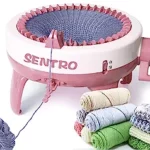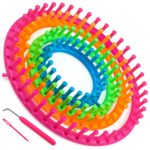You've just completed the last stitch on your knitting project, and a sense of triumph washes over you. The end is near! But then, reality strikes—those separate knitted pieces still need to come together. You squint at the instructions, hoping for a miracle, but it might as well be written in an ancient alien language.
Armed with determination and a vague idea of what "whipstitch" means, you awkwardly fumble with the yarn and your darning needle. With each stitch, you manage to create a beautiful mess that looks like a cross between abstract art and a kindergarten craft project.
Your friend strolls over, admiring your work, oblivious to the chaotic mess you're trying to stitch together. "Oh, it looks great! Just a few more stitches, and you're done!" they cheerfully exclaim. Little do they know the struggle you're facing to keep the pieces from resembling a knitting massacre.
Time ticks by as you wrestle with the fabric, wishing for a magical spell to bring everything into place effortlessly. But alas, there's no knitting fairy to save the day. Your cat, intrigued by the tangled yarn, decides to lend a paw, making matters worse.
With sheer determination, you finally manage to connect the pieces. But as you hold up your creation, it looks like an optical illusion—crooked seams and uneven edges play tricks on your eyes. It's a testament to your creativity and perseverance, but also a warning to any sane person not to inspect it too closely.
Feeling slightly defeated, you bury the wonky creation in your "crafts-to-hide" pile. But hey, it's all part of the learning process, right? Maybe next time you'll tackle sewing pieces together with more finesse—unless, of course, you're secretly a knitting rebel who prefers the abstract charm of a "quirky" finished project!
The Art of Finishing: Seamlessly Sewing Knitted Pieces Together
Knitting is a delightful and rewarding craft that allows us to create an array of beautiful garments and accessories. However, for many knitters, the process doesn't end with the final stitch. The true artistry lies in the finishing touches, particularly in the skillful act of sewing knitted pieces together. Whether you're assembling a cozy sweater, a charming cardigan, or an elegant scarf, mastering the art of finishing ensures that your creations truly shine. In this comprehensive guide, we will explore the techniques, tools, and tips for flawlessly sewing knitted pieces together.
The Importance of Proper Finishing
For many knitters, the thought of sewing pieces together can be a bit daunting, often leading to procrastination or hesitation in completing a project. However, finishing is an integral part of the knitting process, and the way you sew pieces together can make or break the final result. Proper finishing ensures that your garment fits well, lies flat, and maintains its structural integrity.
A well-executed finish is like the cherry on top of a delicious sundae—it enhances the overall appearance and makes your hard work stand out. Additionally, neatly sewn seams can prevent unraveling and ensure that your project lasts for years to come.
Choosing the Right Method
Before diving into the actual sewing process, it's essential to select the appropriate method for joining your knitted pieces. The most common methods are:
- Mattress Stitch: The mattress stitch is a popular technique for joining pieces vertically, such as the sides of a sweater or the arms to the body. It creates an invisible seam, giving your garment a seamless and professional look.
- Backstitch: The backstitch is ideal for sewing together pieces with a visible seam, like shoulder seams or side seams on a bag. It offers more structure and strength to the seam.
- Whipstitch: The whipstitch is often used for sewing together pieces in projects that have bulkier or textured yarn. It provides a rustic finish and adds a decorative touch to the seams.
- Three-Needle Bind-Off: This technique involves binding off stitches from two separate pieces while joining them simultaneously. It's often used for shoulder seams or joining a cowl or collar.
Tools of the Trade
Having the right tools can make the sewing process more enjoyable and efficient. Here are the essential tools you'll need for seamless finishing:
- Darning Needle: Invest in a good-quality darning needle with a large eye that can accommodate your yarn. A blunt tip helps prevent splitting the yarn as you sew.
- Yarn or Thread: Use the same yarn as your knitting project to sew the pieces together. This ensures color consistency and creates a cohesive finish.
- Scissors: Sharp scissors are essential for trimming yarn tails and ensuring a clean finish.
- Tape Measure and Pins: A tape measure helps you ensure that your pieces are aligned correctly before sewing. Pins can be handy for holding pieces in place, especially if you're sewing complex shapes.
Preparing for Sewing
Before you start sewing, take a moment to prepare your knitted pieces. Lay them out flat on a clean surface and block them if necessary. Blocking will help even out the stitches, relax the fibers, and ensure that your pieces have the correct measurements and shape.
If your pattern provides specific guidelines for seaming, make sure to follow them diligently. Pay attention to the direction of your stitches and any specific stitch patterns or stitch counts.
The Mattress Stitch Technique
The mattress stitch is a versatile and widely used method for joining pieces vertically, such as when creating the sides of a sweater or attaching sleeves. This technique creates an almost invisible seam, making it perfect for garments with a clean and seamless look. Here's a step-by-step guide to the mattress stitch:
- Thread the Needle: Start by threading your darning needle with a length of yarn approximately three times the length of the seam you're sewing.
- Insert the Needle: Align the two pieces you want to join with their right sides facing out. Begin at the bottom edge of the pieces and insert the needle under the horizontal bar between the first and second vertical stitches of the first piece.
- Mirror the Stitch: On the second piece, insert the needle under the corresponding horizontal bar between the first and second vertical stitches. Your needle should now be inside both pieces.
- Pull the Yarn Through: Gently pull the yarn through, leaving a small tail at the bottom. Be careful not to pull too tightly, as this can create a pucker in the seam.
- Continue the Process: Repeat the process, moving up the seam. Insert the needle under the next set of horizontal bars on each side, mirroring the stitch on the opposite piece.
- Secure the Seam: Once you reach the top of the seam, weave the yarn tail through the last stitch or two to secure the seam.
- Weave in Ends: Finally, weave in any remaining yarn tails on the wrong side of the fabric, and trim the excess yarn.
The Backstitch Technique
The backstitch is a sturdy method for joining pieces with a visible seam, like shoulder seams on a sweater or side seams on a bag. It offers more structure and is excellent for reinforcing seams that may receive additional stress. Here's how to execute the backstitch technique:
- Thread the Needle: As with the mattress stitch, begin by threading your darning needle with a length of yarn three times the length of the seam.
- Overlap the Pieces: Align the pieces you want to join, ensuring that the right sides are facing out. Overlap the edges, holding them together with your fingers or pins.
- Insert the Needle: Start from the inside of the seam and insert the needle through both pieces, coming out just a stitch or two to the right.
- Create the First Stitch: Reinsert the needle from right to left through both pieces, a short distance away from the starting point.
- Repeat the Process: Continue creating stitches in the same manner, going back and forth between the two pieces, until the entire seam is sewn.
- Secure the Seam: When you reach the end of the seam, weave the yarn tail through the last few stitches on the wrong side to secure the seam.
- Weave in Ends: As always, weave in any remaining yarn tails on the wrong side and trim the excess yarn.
The Whipstitch Technique
The whipstitch is a versatile and straightforward method, especially useful for projects with bulkier or textured yarn. This technique creates a visible seam, adding a rustic and decorative touch to your finished piece. Follow these steps to whipstitch your knitted pieces together:
- Thread the Needle: Thread your darning needle with a length of yarn three times the length of the seam.
- Align the Pieces: Align the pieces to be joined, with the right sides facing out. Hold them together with your fingers or pins.
- Insert the Needle: Starting from the inside of one piece, bring the needle out through the edge.
- Whip the Edge: Bring the needle over the edge and insert it into the corresponding spot on the other piece. The needle should be going over the edge and then back out again, creating a whip-like appearance.
- Continue Whipping: Repeat the process, going back and forth between the two pieces, securing them together.
- Secure the Seam: Once you reach the end of the seam, weave the yarn tail through the last few stitches on the wrong side to secure the seam.
- Weave in Ends: As always, weave in any remaining yarn tails on the wrong side and trim the excess yarn.
Three-Needle Bind-Off Technique
The three-needle bind-off is a unique technique used to join pieces together while simultaneously binding off stitches. It is often used for shoulder seams or when joining a cowl or collar to a garment. Here's a step-by-step guide to the three-needle bind-off:
- Prepare the Stitches: With your right-side facing out, hold the two pieces you want to join parallel to each other. The edges that need to be seamed should be on the outside.
- Insert the Third Needle: With a third needle, knit-wise, insert the needle into the first stitch on the front needle and the first stitch on the back needle.
- Bind Off: Knit these two stitches together as if you were doing a regular bind-off. This will join the two pieces together while binding off the stitches.
- Continue Binding Off: Repeat the process, knitting the next stitches together as you would for a standard bind-off until you reach the end of the row.
- Secure the Seam: Once you finish binding off, weave in the yarn tails on the wrong side of the fabric to secure the seam.
Tips for a Flawless Finish
- Tension is Key: Maintain even tension as you sew to ensure a uniform and neat seam. Avoid pulling the yarn too tightly or leaving it too loose, as this can distort the fabric.
- Consistency in Stitch Size: Try to keep your stitches the same size as the ones you used for knitting to create a cohesive and polished look.
- Block Your Work: After sewing the pieces together, block your finished project to even out the stitches and give it a professional appearance.
- Practice Makes Perfect: If you're new to sewing knitted pieces together, practice on swatches or scrap yarn before tackling your main project.
- Patience and Perseverance: Sewing pieces together can be time-consuming, but the effort you put into finishing will elevate your knitting to a whole new level.
In Conclusion
Finishing is an essential aspect of knitting that requires patience, practice, and attention to detail. Mastering the art of sewing knitted pieces together will elevate your projects to a professional level and ensure that your hard work is showcased in the best possible light. Whether you're creating a cozy sweater, a delicate shawl, or a stylish bag, the finishing touches will transform your knitting from a collection of stitches into a work of art. So, arm yourself with the right tools and techniques, take a deep breath, and dive into the world of finishing with confidence. Happy knitting and seamless sewing!
To find out more about knitting, please visit any of the following areas:
- How to sew together knitting
- What is brioche knitting
- How to join yarn in knitting
- How to join in the round knitting
- How to finish a knitting scarf
- How to make a slip knot for knitting
- How to switch colors knitting
- How to hold yarn when knitting
- What does kfb mean in knitting
- How to fix a dropped stitch in knitting
- How to hold knitting needles
- What is frogging in knitting?
- How to change colors in knitting
- How to count rows in knitting
- How to increase in knitting
- How to slip stitch knitting
- How to yarn over in knitting
- What is a knitting loom?
- How to make bobbles in knitting?
- Where can I buy sentro knitting machine?
- What can you make with a sentro knitting machine?
- Cricut Hat Press: A Comprehensive Guide on Usage - August 13, 2023
- Unlocking Creativity with the Cricut Joy: A Comprehensive Guide - August 12, 2023
- The Ultimate Guide to the Cricut Maker Bundle - August 11, 2023





